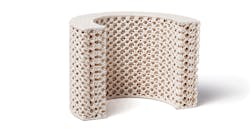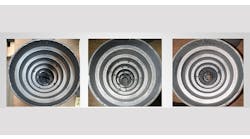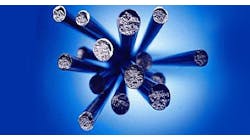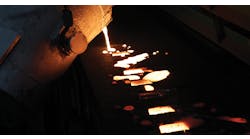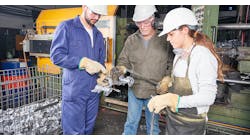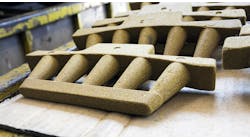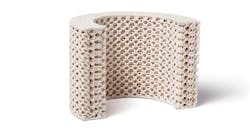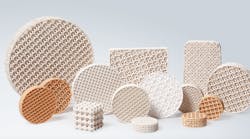A: Traditional reticulated filters have been used for years in many steel foundry casting applications. Due to low-carbon, low-alloy steel’s inconsistent cleanliness and low pouring temperature, and the fact that reticulated filters have a maximum pore size of 10 ppi, the overall capacity of these filters has been restricted to 21 to 30 lbs./in2. This may lead to situations in which a foundry is required to use very large filters and/or multiple filters in complicated gating systems to achieve the surface area required to filter these larger steel castings.
Recently ASK Chemicals developed the EXACTPORE 3D-printed filter that mimics the structure of a foam reticulate. This has provided the benefit of larger pore-sizing while still offering control of laminar flow, with repeatable filter performance. These filters provide capacity increases around 300% or more when utilized in similar steel applications.
Another factor to consider is the purity of the metal being cast. The high structural integrity of EXACTPORE 3D filters ensures the absence of loose particles of filter material that may be entrained in the metal, preventing contamination and time-consuming reworking.
A further advantage of these new filters is a higher flow capacity. Due to the uniformity of the pore design and the structurally consistent geometry, the flow capacity of the EXACTPORE 3D filters is significantly higher than sintered ceramic foam filters with the same filter and pore size, and thus offers foundries an opportunity to increase manufacturing productivity.
The uniformity of the pore design and the structural integrity of the new filters also significantly reduces turbulence during mold-filling, as compared to conventional filters, and protects the metal from reoxidation caused by entrained air. In fact, hardly any impurities enter the mold, which leads to less rework, improved surface quality and lower rejection rates and ultimately increases profitability.
For the casting described above we recommend using a single, 6x6x1.25 in., PSZT, 12.5 MMC filter. This filter could be placed into the runner system in the same manner as traditional foam filters.
Additionally, if yield is extremely important and casting configuration allows it, the EXACTPORE 3D filter can be used in a direct-pour orientation with our EXACTCAST Neckdown Riser with filter ledges. Our EXACTCAST ND 230 and ND 280 have the ability to secure an EXACTPORE 8-in. OD x 1.25 in., PSZT, 12.5 MMC filter, easily meeting the capacity required for this casting. By eliminating the runner system, this product has the potential to improve yield by up to 15%.
Join the Conversation. Email Your Questions for ASK Chemicals Share your insights, opinions, and elaborate on the questions and the experts' answer(s). You must be logged in to the website in order to post your comments.
